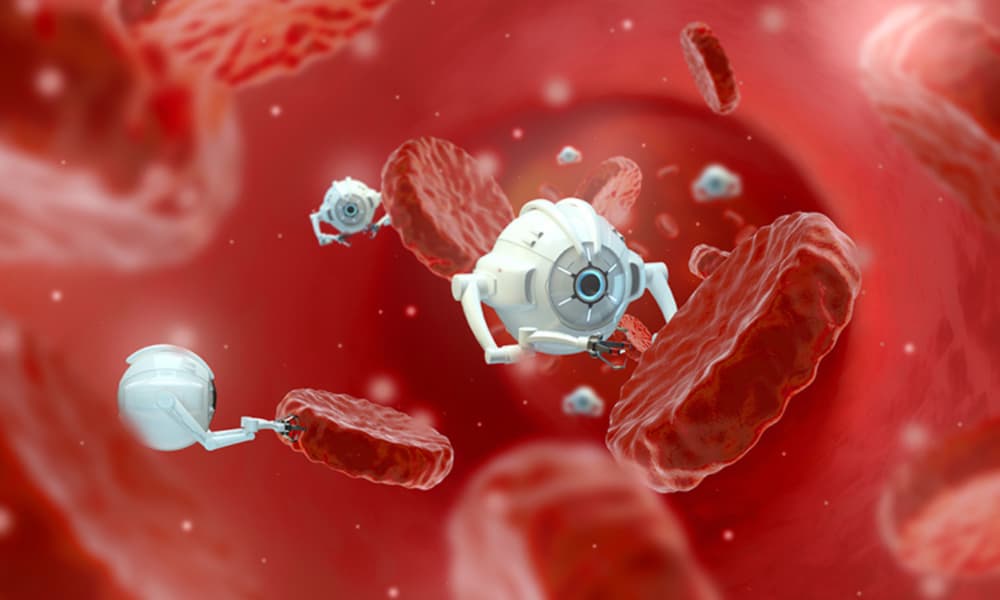Nano-robotics in targeted drug delivery is revolutionizing medicine by using microscopic robots to deliver medication directly to affected areas in the body. This precise approach improves treatment effectiveness, reduces side effects, and can overcome biological barriers like the blood-brain barrier.
Nano-Robotics in Targeted Drug Delivery: Tiny Robots Revolutionizing Medicine
Written by Sumit Kaushik

Imagine a future of microscopic robots which are invisible to the naked eye buzzing about in your bloodstreams delivering medicine right to the site of the disease — no side effects, no medication going down the drain, clean, efficient therapy. It is not a science fiction book; it is the future technology of targeted drug delivery using nano-robotics.
What Is Nano-Robotics in Drug Delivery?
Nano-robotics is an emerging technology that marries nanotechnology with robotics to form microscopic robots — at times only a few nanometers to micrometers in size. The nano-robots are programmed with computers to undertake a specific task in the human body, and one of the most promising applications for the future is drug targeting.
Unlike conventional drug delivery, when medicine is dispersed systemically in the body, nano-robots are able to locate and administer drugs to infected cells or tissue and are more effective with less harm.
How Do Nano-Robots Operate in the Body?
Nano-robots that deliver medications have a variety of excellent characteristics:
- Target Recognition: Molecular sensors are mounted on them that can recognize specific markers on cancer cells, bacteria, or on inflamed tissues.
- Controlled Motion: They move along tissues and blood vessels in a controlled fashion through external magnetic fields, ultrasound, or chemical gradients.
- Payload Discharge: Once at the delivery point in the target region, they release medicine with precise dosage, delivering maximum dose at the correct time.
- Self-Destruction or Removal: After they have carried out their function, most nano-robots might possibly be engineered to degrade harmlessly or be expelled by the body's own processes.
Why Targeted Drug Delivery Matters
Traditional drug delivery systems address the whole body, leading to side effects and lowering the effectiveness of the treatment. For example, drugs used in chemotherapy kill cancer cells alongside normal cells, leading to weakness, nausea, and loss of hair.
Nano-robotics establishes a new norm in that:
- Increases Drug Efficiency: Reduced doses are used for targeted delivery.
- Decreases Side Effects: Healthy tissues are spared from toxins. Healthy tissues are spared from toxins.
- Shattering Biological Barriers: Nano-robots can shatter barriers like the blood-brain barrier and penetrate deeply into tissues.
- Personalized Treatment: Robots can be tailored patient-by-patient and disease-by-disease.
New Developments and Applications
The developments in nano-robotics are astounding:
- Cancer Therapies: Researchers have created nano-robots that journey to cancer tumors and administer chemotherapy only in cancer cells, minimizing damage to healthy tissue.
- Infection Control: Nano-robots can be designed to only target antibiotic-resistant bacteria, depositing antimicrobial agents where infection is occurring.
- Neurological Diseases: Blood-brain barrier penetration, nano-robots offer Alzheimer's, Parkinson's, and brain tumor treatment avenues.
- Autoimmune Disorders: Immune responses are regulated with fewer side effects through targeted drug delivery.
Challenges and Future Prospects
Promising, but nano-robotic drug delivery is not without challenges:
- Safety and Biocompatibility: It is significant not to have the nano-robots elicit immune reactions or toxicity.
- Manufacturing Complexity: It is not simple to mass-produce the small machines reliably.
- Navigation Accuracy: Improving control systems to perfectly navigate robots is a continually focused area.
- Regulatory Approval: Having to go through clinical trials and regulatory systems before widespread usage.
However, with ongoing advancements in material science, AI, and bioengineering, there is much hope for the future. The nano-robotic delivery of drugs is predicted to become the norm within the next decade and transform healthcare.
Conclusion
Nano-robotics in drug delivery is an emerging new branch of medicine with the capability of extremely efficient, tailored, and safe treatments. Nanorobots can be used to heal the so-called incurable diseases, reduce side effects, and usher in a new era of precision medicine.
As technology gets better and better, it is no wonder that patients, doctors, and entrepreneurs hop aboard with nano-robotics. Tiny medical warriors aren't around the corner — and we're going to revolutionize beyond all time how we combat disease.